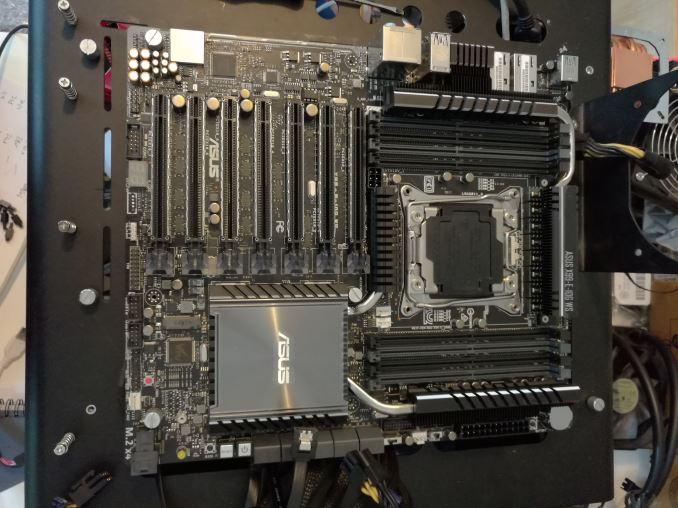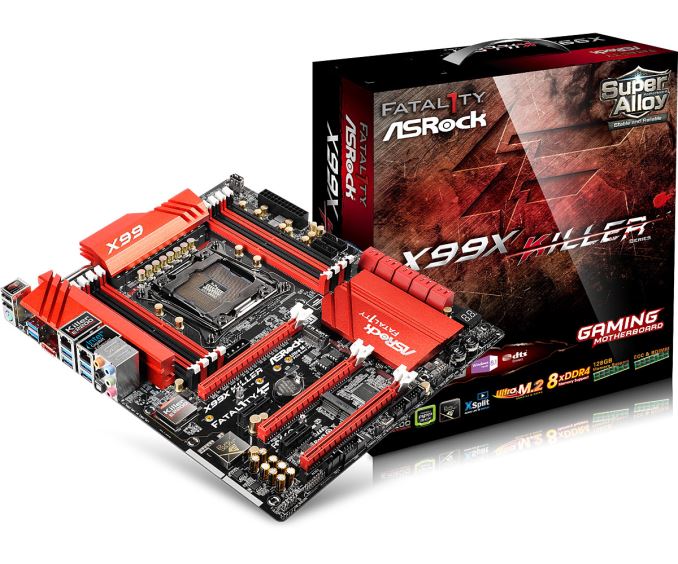The Intel Broadwell-E Review: Core i7-6950X, i7-6900K, i7-6850K and i7-6800K Tested
by Ian Cutress on May 31, 2016 2:01 AM EST- Posted in
- CPUs
- Intel
- Enterprise
- Prosumer
- X99
- 14nm
- Broadwell-E
- HEDT
The Market
At this point in time, Intel is primarily competing with itself. Because the enterprise market requires consistency, the HEDT platform is constrained to that three year, two product cycle, which maintains enough consistency in socket compatibility to keep the enterprise partners happy. When Intel has 95%+ of the HEDT and x86 enterprise market, rather than increasing market share to generate revenue, Intel has to convince users on older systems that their new products are worth the investment. That’s an easy sell in the enterprise market, as time is money and total cost of ownership for a system is typically well documented for cyclical updates.
For HEDT, making that case to prosumers can be difficult. It depends on budgets and how applications are developing, especially when a number of popular professional software packages are (where possible) trying to leverage PCIe accelerators. There will always be a strong market for CPU performance, and there will always be a market for HEDT, depending on the price. But at some point the HEDT and Xeon markets do collide, and the two main factors on this are price and availability.
As mentioned earlier, the newly introduced Broadwell-E Core i7 parts collide in price with a number of Broadwell-EP Xeon parts, which could suggest that Intel wants to push potential prosumers (especially the professional ones) more into systems made by enterprise and workstation partners. These systems are typically sold with appropriate support, and the two platforms differ by a few features. The question becomes about who is buying HEDT: a number of users reading this will be gamers, and will not be interested in workstation sellers.
It’s a strange balance that Intel is trying to strike. Everyone wants more – whether they need it or not is a different conversation – but most enthusiasts say they want more. Intel states that as a company, it supports the gamers and the enthusiasts who want to push their consumer platforms to the fullest, and something like Broadwell-E does that. However a prohibitive price might reduce the potential number of next generation enthusiasts who want to play at the high-end.
X99 Refresh Motherboards
Throughout this month many of the regular motherboard manufacturers have either released, announced, or teased newer "refresh" motherboards using the LGA2011-3 socket and the X99 chipset. We’ve got a base roundup of all the new motherboards coming out of Computex planned, especially as new models are being announced and shown at the show. A couple of these landed on our desk for Broadwell-E testing, such as the MSI X99A Gaming Pro Carbon:
The Carbon is a relatively new brand for MSI’s motherboard range, typically on the high-end models, and this one aims for a deep black aesthetic that is enhanced through the additional LED lighting.
We also have in the ASUS X99-E-10G WS motherboard, ASUS’ high-end workstation and prosumer based motherboard that also integrates an Intel X550-T2 10 gigabit Ethernet chip offering two 10GBase-T ports. We’ve seen this before on the ASRock X99 WS-E/10G, which used the X540-T2, and required eight PCIe 3.0 lanes from the CPU to provide enough bandwidth. We were only able to test the ASUS 10G board for a couple of days before leaving for Computex, and will have a preview up shortly.
ASRock also sent us their X99X Killer, although the courier tried to deliver on a day where I spent 30 minutes gathering stuff for the Computex trip. Go figure. It’ll be ready to test when I get back!
This Review
As with every CPU launch, there are a number of different directions to take our review. In our review of the launch of the consumer Broadwell parts, the i7-5775C and the i5-5675C we examined the generational update over previous architectures, and thus won’t repeat those tests here. We have had almost every high-end desktop CPU since Sandy Bridge-E in-house at some point, although only the latest have been through our most recent benchmark suite. Due to timing, we were able to test all four of the new Broadwell-E processors, and retest the three Haswell-E processors, however we have a more limited dataset for comparison to Ivy Bridge-E, Sandy Bridge-E and Nehalem/Westmere. It will be interesting to see how the CPU performance for the HEDT has adjusted over the last five generations.
The other angle is the recent release of Intel’s Skylake mainstream focused processors, such as the i7-6700K and the i5-6600K, which feature a higher single core frequency but fewer cores and fewer memory channels, or the mainstream enthusiast focused Devil’s Canyon processors released back in July 2014. These have been tested on our latest range of benchmarks, and should make it clear where the latest mainstream-to-HEDT crossover should be.
Test Setup
| Test Setup | |
| Processor | Intel Core i7-6950X (10C/20T, 3.0-3.5 GHz) Intel Core i7-6900K (8C/16T, 3.2-3.7 GHz) Intel Core i7-6850K (6C/12T, 3.6-3.8 GHz) Intel Core i7-6800K (6C/12T, 3.4-3.6 GHz, 28 PCIe 3.0) |
| Motherboards | MSI X99A Gaming Pro Carbon |
| Cooling | Cooler Master Nepton 140XL |
| Power Supply | OCZ 1250W Gold ZX Series Corsair AX1200i Platinum PSU |
| Memory | G.Skill RipjawsX DDR4-2400 C15 4x16GB 1.2V |
| Memory Settings | JEDEC @ 2400 |
| Video Cards | ASUS GTX 980 Strix 4GB MSI R9 290X Gaming 4G MSI GTX 770 Lightning 2GB MSI R9 285 Gaming 2G ASUS R7 240 2GB |
| Hard Drive | Crucial MX200 1TB |
| Optical Drive | LG GH22NS50 |
| Case | Open Test Bed |
| Operating System | Windows 7 64-bit SP1 |
Many thanks to...
We must thank the following companies for kindly providing hardware for our test bed:
Thank you to AMD for providing us with the R9 290X 4GB GPUs.
Thank you to ASUS for providing us with GTX 980 Strix GPUs and the R7 240 DDR3 GPU.
Thank you to ASRock and ASUS for providing us with some IO testing kit.
Thank you to Cooler Master for providing us with Nepton 140XL CLCs.
Thank you to Corsair for providing us with an AX1200i PSU.
Thank you to Crucial for providing us with MX200 SSDs.
Thank you to G.Skill and Corsair for providing us with memory.
Thank you to MSI for providing us with the GTX 770 Lightning GPUs.
Thank you to OCZ for providing us with PSUs.
Thank you to Rosewill for providing us with PSUs and RK-9100 keyboards.













205 Comments
View All Comments
nevcairiel - Tuesday, May 31, 2016 - link
Even if it is, its like 2 years and 2 generations late to the party then. By the time Zen is out, we have Kaby Lake, and they advertise being on-par with not the current, not the previous, but one gen even before that?Spunjji - Wednesday, June 1, 2016 - link
Their claims (if true) would signify rough IPC parity with Broadwell, which Skylake outclasses by a mighty 2.3% according to this site. That was in turn a staggering 3.3% over Haswell so even matching that won't leave them far off the mark. We have no reason to suppose the Kaby Lake release will alter than pattern substantially.It's all big ifs, though, and of course it'll be compared to whatever's out when it finally arrives.
Flunk - Tuesday, May 31, 2016 - link
We can hope I guess, I gave up hope long ago.maxxcool - Tuesday, May 31, 2016 - link
If you are buying a 8 core cpu from EITHER vendor specifically 'game on' your a proper idiot, tool and dumbass.JoeyJoJo123 - Tuesday, May 31, 2016 - link
If you are telling people what they can and can't do with their money along with slinging personal attacks, you're a proper idiot, tool, and you need to get a job so you can manage your own money, rather than someone else's.Seriously though. This is the internet. You should really stop caring about what other people spend their own money on. People much richer than these kids are spending money on sports cars and getting into a wreck a week later, often involving other vehicle(s) and/or innocent people.
I really couldn't care less if 10,000 people on this article's comments section thought the new extreme edition processor was a "good value" and bought one (or more). More power to them.
hoohoo - Tuesday, May 31, 2016 - link
AMD is not a charity.AMD will charge as much as the market will bear.
Ninety percent of the performance probably costs about ninety percent the price.
Michael Bay - Wednesday, June 1, 2016 - link
>supposed to be>Zen
At this point in time it`s not even remotely funny anymore.
Bulat Ziganshin - Saturday, June 4, 2016 - link
>Zen is supposed to be really, really close to Broadwell in IPC.are you really believe that AMD, who was a lot behind Intel back in 2008, and then lost a few years on Bulldozer development, in a miraculous way will jump over? i expect that Zen will be a little better than their last Phenom, and that their first implementation of SMT will be as inefficient as Nehalem one. And higher core count, as well as AMD huge lag in lowering-heat-dissipation technologies, will mean more heat and therefore stricter limits on frequency - the same limits as in 10-core Broadwell and probably even stricter. So it may be like 8-core Nehalem at 4 GHz (with best overclocking). That's better than i7-6700K for multi-threaded tasks, but of course slower for tasks with 1-4 threads, including most of games. Or you may continue to believe in Santa :)
jchambers2586 - Tuesday, May 31, 2016 - link
you spend $434 on a CPU and it does not perform than a $ 250 6600K in gaming you would think spending more would get you better gaming performance. I don't' think spending $434 on the i7-6800K is worth it for gaming.beginner99 - Tuesday, May 31, 2016 - link
This is the take-away. Useless for gaming for now. If 6-cores will actually benefit from DX12 remains to be seen. If I were I game developer I would focus on making use of the iGPU versus scaling above 4-cores because most of my user base has an idling iGPU and very few more than 4 cores.If it would at least have edram. For broadwell it's 5775c or else skylake for gaming.